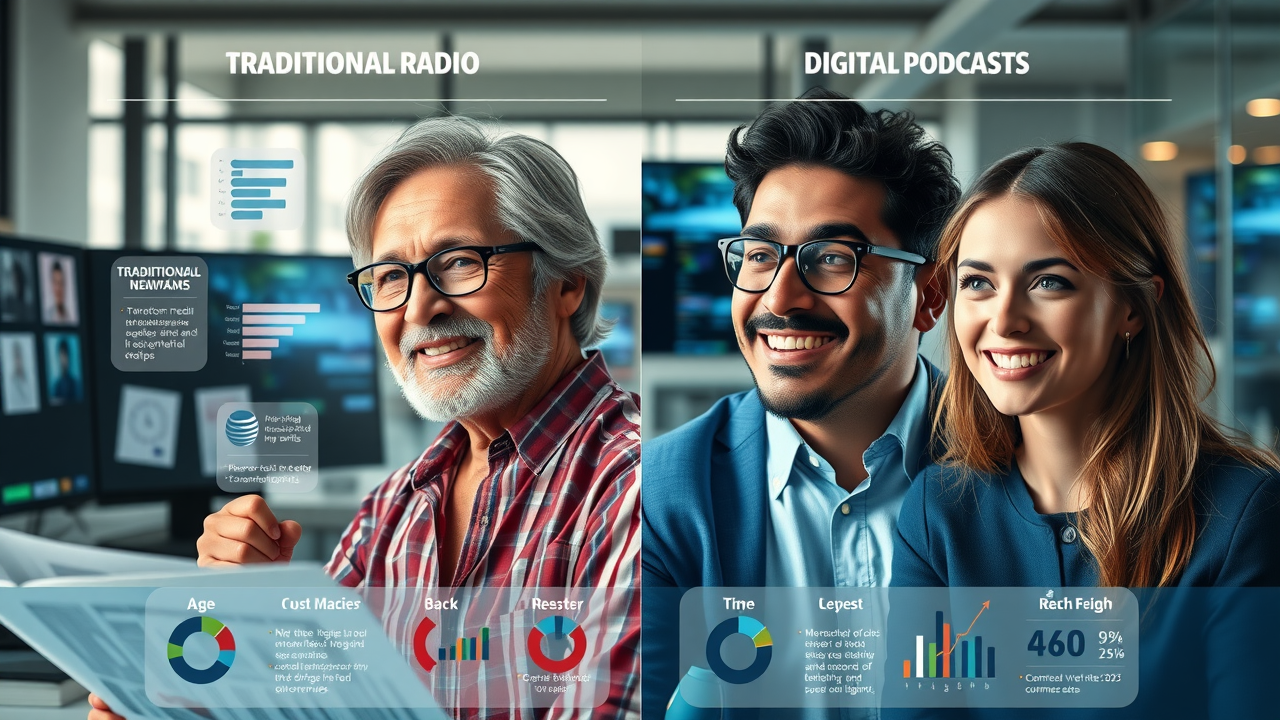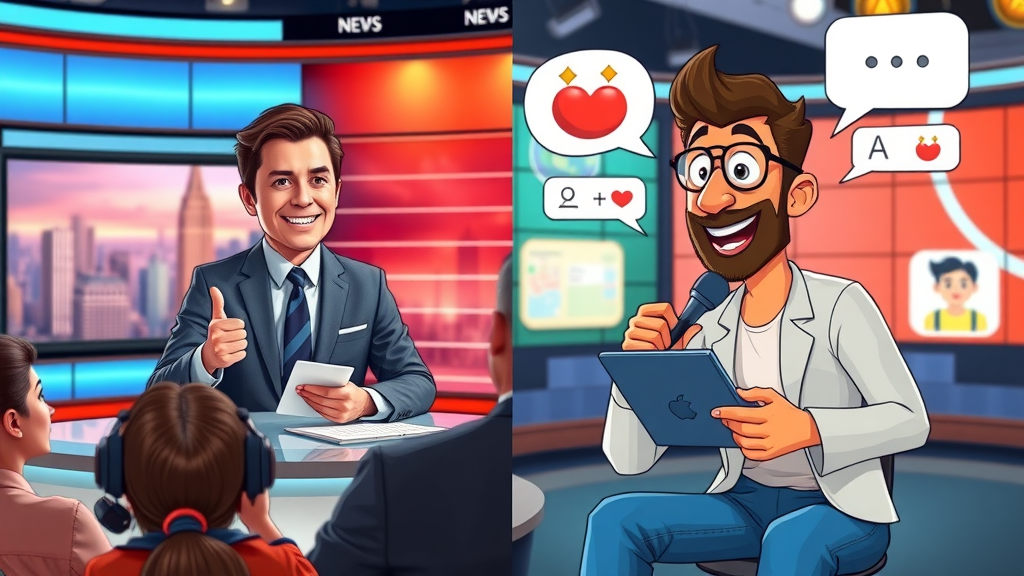Did you know? In 2025, an astonishing 80% of people under 40 consume their news online, while over 60% of those over 55 still rely on TV and print. The battle of traditional vs digital media isn't just alive—it's evolving faster than ever. Whether you're a marketer, business leader, or everyday consumer, understanding this ongoing shift is critical to making informed choices in a fragmented media landscape.
What You’ll Learn: This article reveals why the debate between traditional and digital media in 2025 remains relevant, outlines key features of both, compares their strengths, reveals marketing strategies, considers the rise of social media, and provides expert insights—all to help you make the smartest media choices for your goals.
Why ‘Traditional vs Digital Media’ Is Still the Big Question in 2025
The divide between traditional vs digital media is a defining factor for businesses, consumers, and media outlets in 2025. People want to know: Is digital media now the clear winner, or does traditional media still hold unique advantages? It isn’t black and white. From local news delivered by trusted TV anchors to viral social media platforms shaping young minds, every type of media fulfills different user needs. Most importantly, the real question is not just which one is better, but how they overlap and where each shines for reaching target audiences. If you’re a PR professional, marketer, or business owner, your products and services don’t exist in a vacuum—and neither do your audiences. That’s why understanding this distinction remains at the forefront of any effective marketing strategy.
For example, a major sporting event may generate real-time buzz on Twitter and Instagram, but millions will still tune into live TV broadcasts or catch up via radio recaps. Meanwhile, brands aiming for credibility may prefer trusted print magazines, while startups needing quick viral reach target digital platforms. Understanding the coexistence and competition of traditional and digital media will help you adapt to the shifting tides and reach your audience where they’re most engaged.
The Shift: A Startling Statistic about Traditional and Digital Media Consumption
Every year, the gap between those consuming traditional and digital media broadens. According to a 2025 consumer study, daily digital media consumption has surpassed traditional media by more than 35% among all demographics under 45. At the same time, for people over 60, traditional formats like TV news and local newspapers still command double the daily attention spent on digital sources.
This duality means that, despite the irreversible shift towards smartphones, social media, and on-demand streaming, there is still a large, loyal segment consuming traditional media daily. Many businesses find that only a hybrid approach ensures complete coverage: a digital marketing campaign backed by a television commercial or a print ad complemented by an Instagram push.
The ongoing changes in audience preferences and media platforms mean that both forms of media remain essential. Media marketers and PR professionals continue to strategically balance both to maximize reach, engagement, and ROI.

What You’ll Gain from Understanding Traditional vs Digital Media Today
Grasping the key differences and similarities between traditional and digital media is vital, whether you’re a small business owner, a media professional, or just an informed consumer. In 2025, media landscapes shift rapidly, and knowing where—and how—your intended message will have the greatest impact is priceless.
You’ll learn which media channels best suit your marketing goals, gain confidence in choosing the right media outlet, and understand how to tailor your messaging for various target audiences. This knowledge empowers you to maximize your media marketing efforts and avoid expensive trial-and-error campaigns.
Armed with insights from real-world marketing campaigns, expert advice, and up-to-date statistics, you’ll be prepared to make strategic decisions—whether that means leveraging the prestige of print or the viral power of digital media platforms. Ultimately, understanding this divide is your key asset for success in a complex media environment.
Defining the Stakes: What Is Traditional Media in 2025?
In 2025, traditional media refers to longstanding media formats that have shaped global communication for decades. These include print (newspapers and magazines), broadcast TV, radio, direct mail, outdoor advertising (like billboards), and the once-ubiquitous telephone. Despite waves of digital transformation, these media still play a vital role, especially for reaching older generations and for lending authority to products and services.
Traditional media offers unique trustworthiness and proven reach, especially for brand-building and local news. Media outlets in this space still command large advertising budgets from brands seeking demographic stability and established credibility. Whether you’re a PR professional aiming for broad appeal or a company seeking trusted coverage, traditional media remains relevant in the ever-evolving media landscape.
Key Channels in Traditional Media: Print, TV, Radio, and More
Traditional media includes more than just newspapers and TV news. In 2025, it encompasses magazines, radio broadcasts, cable and network television, direct mail campaigns, telephone outreach, and classic outdoor signage. These channels remain critical for certain sectors, such as politics, healthcare, and community news—fields where depth, trust, and regulatory compliance are paramount.
Their primary characteristics include one-way communication , limited segmentation, and a focus on reaching large audiences efficiently. For example, a local business may use radio to reach commuters, place ads in city magazines for a specific zip code, or target retirees with printed newsletters—each a type of media that’s proven and trusted in its niche.
Despite the surge in digital market competition, many consumers associate traditional media with legitimacy and reliability. Institutions and established brands still turn to these outlets for trustworthy coverage and broad awareness campaigns.
Print: Newspapers, magazines, trade journals
Television: National and local broadcast channels, cable news, TV news programs
Radio: AM/FM talk, news, and music stations
Outdoor: Billboards, transit ads, posters
Telephone: Telemarketing, automated calls
Direct Mail: Flyers, catalogs, postcards
How Digital Media Has Eclipsed and Evolved Since 2020
The landscape of digital media has changed dramatically since 2020. Driven by the explosion of internet connection speeds, the proliferation of smart devices, and the rise of streaming and social media platforms, digital media now dominates the attention of global audiences. In 2025, examples of digital media extend far beyond websites and email; they encompass immersive video streaming, real-time social engagement, influencer marketing, and podcasts—media formats that are interactive, measurable, and easily targeted.
What sets digital media apart is its interactivity and precision targeting. Brands can tailor messages for specific demographics, track real-time engagement, and reposition campaigns instantly. With consumers accustomed to on-demand access and personalized feeds, digital media platforms have become the primary means for building communities, sparking viral trends, and collecting invaluable audience feedback.
Exploring the Diversity of Digital Media Platforms
Today’s digital media platforms come in countless forms—each designed to connect, entertain, or inform. From social media giants like Facebook, Instagram, TikTok, and Twitter, to streaming services such as Netflix and YouTube, to the ever-expanding world of podcasts and niche communities, the digital sphere is more diverse and dynamic than ever.
Unlike traditional media, which relies heavily on a one-way broadcast, digital channels thrive on two-way interactions. Personalized feeds, direct messaging, comments, and community-building tools put users in control. This shift means that brands must now develop sophisticated digital marketing strategies, leveraging real-time analytics, influencer partnerships, and content tailored to segmented target audiences for maximum effect.
Moreover, the convergence of virtual and augmented reality is ushering in new ways for audiences to experience media, making digital channels not just informative, but immersive and interactive. This is revolutionizing how people consume information, connect with brands, and participate in the public sphere.
Social Media Platforms: Instagram, Facebook, TikTok, Twitter, LinkedIn
Streaming Services: YouTube, Netflix, Spotify, Hulu
Podcasts and Audio Platforms: Apple Podcasts, Spotify, Clubhouse
Websites/Blogs: News media outlets, content marketing sites
VR/AR Experiences: Interactive events, AI-driven news delivery

Traditional and Digital Media: Key Similarities, Differences, and Overlaps
Both forms of media aim to inform, persuade, and entertain their audiences—yet they do so using fundamentally different techniques. The overlap between traditional and digital media is growing as established outlets launch digital arms (think: TV news streaming apps or digital subscriptions for newspapers), while digital-only brands occasionally partner with print or radio for credibility.
The primary difference is interactivity. Traditional media typically broadcasts one-way messages to large audiences with little immediate feedback, whereas digital media leverages instant interaction and data-driven targeting. However, their paths now cross more than ever, with hybrid campaigns blending the trust of TV with the reach of social media, or newspapers boosting stories online and through podcasts.
Ultimately, understanding the nuances and overlaps between traditional and digital media enables you to create a multifaceted media marketing plan that takes advantage of each channel’s strengths, maximizes cost efficiency, and builds greater trust with diverse target audiences.
Table: Comparing Traditional vs Digital Media Features in 2025
Feature |
Traditional Media |
Digital Media |
|---|---|---|
Reach |
Broad, mass audiences (local news, national TV) |
Highly targeted, global reach (social media, niche platforms) |
Cost |
High (TV ads, print placements) |
Variable; low barrier to entry (social campaigns, PPC ads) |
Interactivity |
Limited; one-way communication |
High; two-way conversations, real-time feedback |
Targeting |
Limited segmentation (demographics, geography) |
Precise user targeting (behavioral, psychographic) |
Speed |
Slower; production and distribution timelines |
Instant content deployment and edits |

Media Marketing in the Era of Traditional and Digital Media
In a world where both traditional and digital media matter, successful marketing strategies blend credibility with agility. A robust campaign might launch a new product with a prime-time TV spot (for broad credibility) and follow up with influencer-led Instagram stories and TikTok challenges to spark virality and interaction.
Brands must weigh their objectives, budget, and audience before deciding which media formats suit them best. While digital campaigns are often cost-effective and data-rich, traditional platforms lend prestige and trust—especially for sectors like finance, health, or luxury products. The savviest media marketers craft campaigns that deliver both reach and ROI, evaluating type of media based on the end goal.
Modern marketers also recognize that many consumers traverse both worlds. Someone might hear about a new movie via radio ads and then purchase tickets through an online platform, highlighting the need for an integrated media marketing approach.
Marketing Strategies: When to Use Traditional or Digital
The key to choosing the right media channel often comes down to audience intent and marketing objective. Traditional media shines when you need to build widespread credibility (such as launching a national campaign or targeting older customers familiar with TV and print). Digital platforms excel for rapid experimentation, measurable ROI, and capturing the attention of younger, online-native audiences.
Remember: Smart campaigns leverage the strengths of each. For example, a television commercial can create broad awareness, while a highly targeted Facebook ad campaign hones in on people most likely to convert. Data-backed digital efforts complement the trustworthiness of traditional journalism, creating a powerful one-two punch for media marketing in 2025.
Traditional Media Campaigns: Best for brand prestige, regulatory industries, and building trust
Digital Media Campaigns: Ideal for rapid scaling, testing concepts, and engagement with younger or global audiences
Integrated Approaches: Combine TV/radio with trending hashtags, influencer partnerships, or real-time social engagement
Addressing Social Media’s Influence within Traditional vs Digital Media
Perhaps no change in the media landscape is more pronounced than the rise of social media platforms. While social media began as a purely digital phenomenon, in 2025 it’s become a connective bridge—integrating both traditional and digital media.
Media outlets now use Twitter and Instagram to tease breaking news before it airs on TV, while digital natives reference television clips on TikTok and Reddit. Social media has created a feedback loop where stories evolve, amplify, and sometimes even disrupt both traditional and digital narratives. Whether you’re a PR professional managing a crisis or a brand launching a campaign, ignoring the explosive influence of social media is simply not an option.
The Explosive Growth of Social Media in Digital Media
Social media’s expansion is breathtaking: In 2025, over five billion people log on daily, making platforms such as TikTok, Twitter, and Instagram vital media channels in their own right. These platforms aren’t just places to chat—they are now primary sources for news, opinion, and entertainment, outpacing even established TV news and local newspapers.
The unique value of social media lies in its ability to unite the reach of traditional media with the engagement and granularity of digital. Stories go viral in minutes, real-time feedback shapes narratives, and brand reputations can rise or fall overnight. For marketers and media professionals, mastering social media is now inseparable from mastering the modern media landscape.
"Social media is not just a channel; it’s the connective tissue uniting traditional media and digital media in the modern media ecosystem."

Cost, Reach, Trust: The Metrics that Matter in Traditional vs Digital Media
Selecting the best media format means weighing cost, reach, and trust —the three pillars of successful media marketing. Digital channels offer granular targeting, dynamic pricing, and instant feedback; traditional channels provide wide coverage and deep-rooted credibility. Understanding these metrics allows marketers to get the most for their budget while reaching target audiences efficiently.
While digital platforms are revolutionizing how and where messages travel, many legacy brands still invest in TV or print to build perception, especially when trust is paramount. In turn, digital metrics provide the agility needed to quickly pivot, track results, and maximize return on investment—a win for agile, data-driven campaigns.
List: Critical Advantages & Disadvantages of Traditional and Digital Media
Traditional Media Advantages: Trust, mass reach, established standards, evocative experience (TV/radio)
Traditional Media Disadvantages: High cost, slow adaptation, limited targeting, hard to measure ROI
Digital Media Advantages: Low cost, precise targeting, two-way interaction, real-time analytics, broad accessibility
Digital Media Disadvantages: Trust issues (fake news, privacy), ad fatigue, rapidly shifting algorithms
Case Studies: How Leading Brands Choose Between Traditional and Digital Media
In 2025, the world’s top brands often deploy a mix of traditional and digital media to achieve the best results. For instance, car manufacturers still air Super Bowl TV ads (for mass awareness), but follow up with geo-targeted mobile ads and sponsored influencer content to drive dealer visits and social media engagement.
Meanwhile, global apparel brands might launch exclusive products with influencer-led TikTok challenges, driving immediate sales and engagement online—then solidify brand status with full-page print spreads or subway ads in major cities. This blend demonstrates how recognizing the strengths of each media format can yield tremendous marketing success.
The savviest marketing campaigns thrive at the intersection of credibility and engagement , carefully tracking analytics to evolve over time.
Real-World Media Marketing Campaigns in 2025
Consider the 2025 launch of a new eco-friendly beverage: The company ran TV commercials to build trust with an older audience, simultaneously launching interactive TikTok campaigns and partnering with wellness influencers. Their integrated strategy netted both broad awareness and viral digital engagement, proving once again that traditional and digital media, when fused, are more powerful together.
In another example, a financial services brand sponsored a televised debate on economic trends, then drove viewers to their mobile app with QR codes and interactive polls promoted on social media. By blending established media outlet gravitas with forward-thinking digital marketing, they reached diverse demographic segments in a single, coordinated push.

What is the main advantage of digital media over traditional media?
The main advantage of digital media is its enhanced ability to target, measure, and engage audiences. Unlike traditional media—a TV news spot, for example—digital channels like Facebook or Google Ads let marketers specialize messages, track user responses instantly, and tweak ads in real time based on performance data.
Digital platforms also encourage two-way conversations, allowing for direct engagement, feedback loops, and viral sharing. This makes digital media the preferred choice for brands aiming for rapid growth, cost-effectiveness, and personalized interaction in today’s dynamic media landscape.
Digital Media’s Predominance: Enhanced Targeting, Measurement, and Engagement
Sophisticated analytics and user data put digital media ahead for many marketing campaigns. Brands can drill down to individual behaviors and preferences, ensuring their media marketing efforts reach relevant target audiences with messages that convert. This flexibility offers a decisive edge over traditional, broad-cast approaches, boosting both efficiency and ROI.
That said, the best strategies recognize when to use digital’s strengths and when to rely on the time-tested trust of traditional media platforms.
What is one key difference between traditional and new media?
The key difference is the level of interactivity. Traditional media (such as newspapers or TV news) broadcasts information to passive audiences, which can only respond through delayed channels like letters or phone calls. New (digital) media, on the other hand, thrives on real-time feedback, sharing, and two-way engagement.
This shift has transformed expectations—today’s consumers want to participate, comment, and even shape the narrative rather than just absorb it.
Digital Interactivity vs Traditional One-Way Messaging
While traditional and digital media may report the same story, digital media platforms enable immediate user responses—likes, shares, retweets, live comments—making every piece of content a two-way street. This fundamentally changes how brands and individuals connect, influence opinion, and drive action.
Such media formats encourage greater transparency, community-building, and real-time crisis management, advantages that are impossible to achieve with broadcast-only models.

What are the 6 traditional media?
The six traditional media channels most often referenced in 2025 are: Print, Radio, TV, Telephone, Outdoor (billboards, transit), and Direct Mail. Each of these formats offers unique benefits, such as the high visibility of billboards or the trust of local radio—and each remains strong in select industries and markets.
A Comprehensive List: Print, Radio, TV, Telephone, Outdoor, and Direct Mail
Print Media: Newspapers, magazines, trade publications
Radio: AM/FM news, talk, and music stations
TV: Network, cable, and local TV news programs
Telephone: Telemarketing, surveys, customer outreach
Outdoor Media: Billboards, posters, transit ads
Direct Mail: Postcards, catalogs, flyers to households
What is the difference between traditional and digital media channels in advertising?
Traditional media advertising is typically about reaching broad audiences with limited personalization or feedback, such as a television commercial that airs to millions. Digital media, by contrast, allows for precise targeting, instant measurement, and real-time adaptation of ads.
This gives digital channels an unmatched flexibility to test, optimize, and customize messages for particular segments, ensuring higher effectiveness and often much lower cost per engagement.
Advertising Reach, Targeting, and Measurability: Traditional vs Digital Media Channels
Traditional advertising favors mass messages and long planning cycles; while digital marketing is agile, responsive, and backed by a wealth of analytics. Companies seeking to maximize budget and engagement must carefully select media platforms according to their goals, constraints, and audience profiles.
A modern marketing strategy might combine billboard awareness with highly targeted TikTok ads for the best of both worlds.
The Future of Traditional vs Digital Media: Are We Headed for Integration or Dominance?
Looking into 2025 and beyond, most experts agree: The future of the media landscape lies in integration , not outright dominance. Brands that can merge the credibility of traditional journalism with the speed, analytics, and engagement of digital media will thrive as user habits continue to shift.
Innovative campaigns, seamless omnichannel experiences, and fluid movement between physical and digital spaces are already defining the leading strategies of tomorrow.
Expert Opinions and Key Trends in Traditional and Digital Media
Media professionals anticipate further blurring of the old lines. Trusted media outlets are launching podcasts, local news goes mobile, and brands use print to boost online virality. The rise of immersive technologies—VR and AR—combined with evolving data privacy regulations, are reshaping how marketers approach both traditional and digital platforms.
Experts predict that brands who blend authenticity, adaptability, and analytics will stand out, using every available type of media to optimize engagement and build community.
"The success of future media marketing lies in a brand’s ability to merge the credibility of traditional media with the agility of digital media."
Frequently Asked Questions on Traditional vs Digital Media
Q: Is traditional media still relevant in 2025?
A: Absolutely. Traditional media platforms like TV news, radio, and print remain vital for certain demographics and for building trust—especially in finance, healthcare, and local news sectors.Q: Can digital media replace traditional media entirely?
A: Not entirely—many brands use a hybrid approach to maximize their reach and impact, leveraging the trust of traditional outlets with the engagement of digital platforms.Q: What is the main disadvantage of digital media?
A: While digital media is fast and measurable, it faces challenges around information trust (fake news), ad fatigue, and privacy concerns.Q: Do all age groups prefer digital media?
A: No. While younger audiences lean heavily digital, older consumers often trust traditional media formats more. Effective marketing requires multi-channel strategies.
Expert Panel: Traditional Media vs Digital Media Debate for 2025
Watch a top-tier panel of media professionals debate the most pressing issues in traditional vs digital media : integration, audience trust, data privacy, and what marketers must do to stay ahead.
Summing Up the Winners: Traditional vs Digital Media in 2025
Key Takeaways: Making the Best Media Choice for Your Needs in 2025
In 2025, it’s not traditional versus digital—it’s both: Select your channel based on your audience, your goals, and your brand’s unique strengths. The savviest brands combine the best of both worlds in an integrated, responsive media marketing strategy.
Ready to future-proof your reach? Strategize your campaigns with a blend of traditional credibility and digital agility to engage audiences wherever they are—and win in 2025’s media landscape.
In 2025, the media landscape continues to evolve, with digital platforms increasingly dominating over traditional media channels. For instance, in the UK, online platforms such as Facebook, YouTube, and TikTok have surpassed television as the primary sources of news, with 71% of adults obtaining news online compared to 70% via TV. ( ft.com ) This shift is even more pronounced among younger audiences, where over 80% of individuals aged 16-24 rely on social media for news consumption.
Similarly, in the United States, digital video advertising has overtaken traditional TV ad spending. In 2024, digital video, encompassing streaming services like Netflix, social platforms such as TikTok, and free ad-supported TV like Pluto TV, accounted for $62.9 billion of U.S. ad spending, representing 52% of the total projected video ad expenditure. ( reuters.com ) This trend underscores the growing preference for digital media among advertisers aiming to reach targeted audiences more effectively.
The rise of platforms like TikTok and Instagram has also transformed content consumption patterns. Short-form videos now dominate, leading to a decline in traditional news consumption. This evolution favors influencers and content creators over traditional journalists, resulting in a media landscape that is more fragmented and open to controversial content. ( ft.com )
Despite the rapid growth of digital media, traditional channels still hold value, particularly for reaching certain demographics and lending credibility to brands. However, the ability of digital media to offer precise targeting, real-time engagement, and cost-effective solutions makes it an increasingly attractive option for marketers and consumers alike.
Understanding the strengths and limitations of both traditional and digital media is crucial for developing effective marketing strategies in today’s dynamic environment.
Ready to improve your brand with an owned media channel?
Visit MediaAuthorityGroup.com/blueprint or call 843‑997‑1127 and let’s build your content engine.
 Add Row
Add Row  Add
Add 




Write A Comment